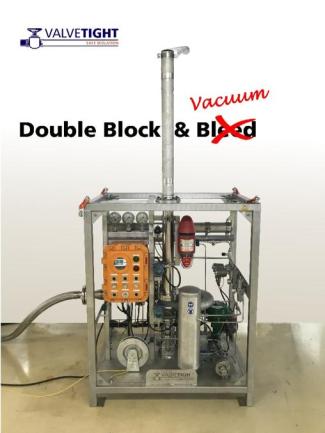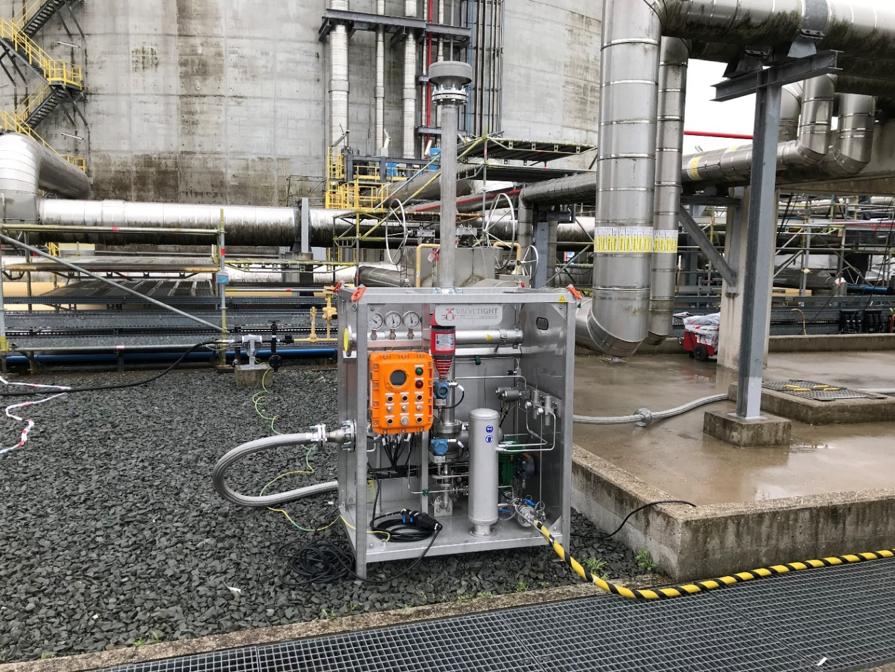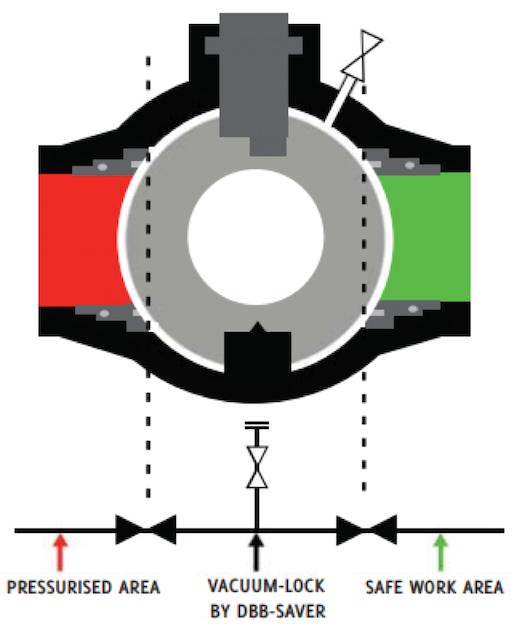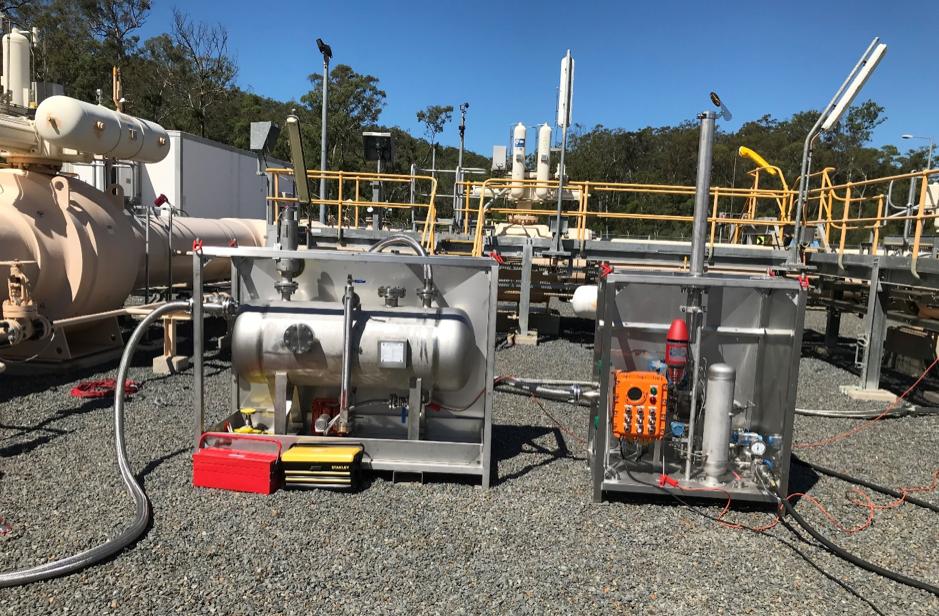
Working behind leaking valves: dilemma between safety and operational targets
When maintenance is planned on part of an installation, while the remaining installation remains pressurized and operational, the equipment in question must be safely isolated from the rest of the installation. With the DBB-SAVER, a unique solution is being offered, and safe maintenance can be carried out without further shut downs.
About the Author
Jeroen Pronk, founder and owner of Valvetight, used to be a plant manager for over 15 years of several plants in the oil and gas industry. When he was confronted with leaking valves too often and difficulties in repairing/maintaining these, he invented the vacuum-lock method known as the ‘DBB-SAVER’. Knowing leaking valves were a problem all over the world, he filed for patent and founded Valvetight in 2014.
Introduction
In the current situation, the modus operandi is to close isolation valves, often Double Block & Bleed (DBB) or Single Valve (SV) configurations. In some occasions this is followed by the installation of a blind flange. However, often the valves in question are leaking, which makes safe execution of the maintenance work (or safe instalment of blind flanges) hazardous and not allowed. When valves are leaking beyond the acceptable leak rate and valve repair is not practically feasible, what are your options, and what are their consequences?
- It is possible to shut one or more valves upstream. This however will result in a larger or total shutdown.
- The second option is to postpone the maintenance, which leads to higher cost, amongst others due to cancelations in maintenance crew reservations and other already taken measures.
- Injecting grease, if possible, is another option. There is a danger though that this grease will disappear and cause a sudden, non-predictable, blow through.
- injecting sealants could also be an option, but often renders a valve not fit for purpose afterwards, and can cause heavy in-line leakage when this particular valve is taken back in operation. Besides this, the risk of a sudden blow through remains.
Finally, there is a last resort in which leakage is ‘accepted’ and additional measures need to be taken, such as gas detection, the use of explosion safe tools or workers wearing personal protection equipment. But these are last line of defense measures, and dependency on those should be avoided!

Creating a vacuum
None of the above options is ideal. Hence the development of the DBB-SAVER. This piece of equipment solves the problem of leaking valves at the source, without any modification or repair. The functioning principle is based on creating a vacuum in either the volume between two block valves in a classical DB&B configuration, or the cavity between two sealing seats in the body of a single valve (ball, plug or gate). This vacuum creates a negative pressure difference towards the safe work area and makes leakage of gas and/or liquids towards the safe work place physically impossible.
The vacuum is automatically controlled and monitored. The DBB-SAVER design is completely failsafe, fully certified and equipped with several lifesaving alarms. The alarms will be audible and visible on the location of the DBB-SAVER, and can also be made available through remote alarms on the safe work place and on separate alarm monitors in the operator control room.
Shell’s view on the DBB-SAVER
“A solution is required when valve(s) are leaking beyond an acceptable leak rate and valve repair results in unacceptable outage or is just not possible without shutting down the plant”, Tony Smart (Shell Global Solutions) says.
“Shell worked in collaboration with Valvetight to develop a Technical Release Acceptance for deployment of the DBB-SAVER technology and this was proven out on field trials successfully.” Smart (Subject Matter Expert, Valves) was responsible for coordinating a multi-disciplinary “technical development review”. “The DBB-SAVER was assessed by the Technical Experts of all involved departments. After the addition and factory tests of a blocked bleed alarm functionality PTE TA1 approval was obtained to use the DBB-SAVER within our company. In certain situations, the DBB-SAVER can be really beneficial in achieving the desired level of safety when working on isolated equipment, whilst preventing the shutdown of bordering installation parts.” To create awareness within Shell globally, the report is now available on the company’s intranet, describing the DBB-SAVER technology as PTE TA1 endorsed for easy acceptance and deployment in any asset.
More recently the Shell global solutions department have updated the technology approval report, and actively promote the DBB-SAVER solution within Shell globally. This new report can also be found on Shell’s intranet, and recommends the Valvetight DBB-SAVER for use on all of their assets worldwide when dealing with leaking valves.
Dilemma solved
For aging assets with outdated safety concept or installations where space and weight were important design factors (e.g. offshore installations), often there is only a single isolation valve installed whereas there would ideally be a DB&B configuration. Often these valves are ball, plug or gate valves, and have a body cavity vent or drain, or a provision to make one.
When a DBB-SAVER is connected to the body cavity and a vacuum is created between the up and downstream seal of a single valve, the in-line leakage through the valve towards the safe work area can be 100% mitigated. This creates many new safe isolation possibilities.

In short, with this piece of equipment, all of the above dilemmas are solved: the remaining part of the installation stays operational which means that both operational targets and required safety levels are not jeopardized as the equipment can certainly be isolated. Therefore the maintenance planning becomes predictable. No greasing means no risk of sudden gas blow through, no use of sealants, ensuring the valve stays fit for purpose afterwards and last but not least, there is no dependency on the last line of defense PPE.
Experiences in the field and Shell approval
Although Valvetight, the inventor of the DBB-SAVER, is a relatively young company, it has built up an impressive track record already. Major companies in the oil & gas and petrochemical industry, like Shell, Aramco and BP are relying on the DBB-SAVER already, which besides the additional safety features, also saved them considerable downtime.
NAM (Nederlandse Aardolie Maatschappij, ed.), being a Shell-operated company, has forwarded the technology within the Shell HQ, which after thorough reviews on Shells ultimate Technical Authority level was assigned as “approved third party technology, for use on all assets” (see text box “Shell’s view on the DBB SAVER”). Shell even refers to the DBB-SAVER on their intranet for promotion and easy acceptance towards their plant operators when dealing with leaking valves. Particularly proud is Valvetight of Shell’s approval, and more recently recommendation, of the DBB-SAVER technology and equipment, which is a huge recognition. “Shell takes no shortcuts, and zero leakage is zero leakage, which can actually be enforced by the DBB-SAVER.”

Hands-on experience
Albert Kolk, operations & maintenance manager at NAM, has had hands-on experience with the DBB-SAVER in the field. Kolk, who is employed at one of the underground gas storage facilities in the north of the Netherlands, has used this tool five times during the one year test phase, after which they decided to have their own dedicated unit for future use.
“The DBB SAVER is relatively easy to use and does what it is supposed to do. It takes approximately half a day to train maintenance personnel to install the unit, to set up the parameters and to start the warning system via the PLC. The basic parameters as well as certain pre-alarm parameters are already set, for example, the leak rate increase alarm level or the blocked bleed alarm, but it can be adapted to our preferences.” Kolk says the DBB SAVER he has in his possession has a design capacity of 2.400 liters/minute. “This is more than enough to handle the majority of the leak rates we experience. In case we have extreme leakage, we will try to reduce the leakage as far as possible anyway (e.g. by greasing), and we can use our DBB-SAVER to handle the remaining leakage. In case the leakage increases again, the DBB-SAVER will alarm us as soon as this occurs. The safe connection of the DBB-SAVER is an important factor also. We connect the DBB-SAVER on a bleed valve which is opened only after we have a good indication of the occurring leak rate, which must be well below the capacity of our DBB-SAVER model.”
In this article, gas and liquids are referred to as the leaking medium. Also, cryogenic and LNG applications have been performed with the DBB-SAVER.
Moreover, the DBB-SAVER is also fully certified and applicable for hydrogen applications, thus being able to assist in the upcoming energy transition as well.

